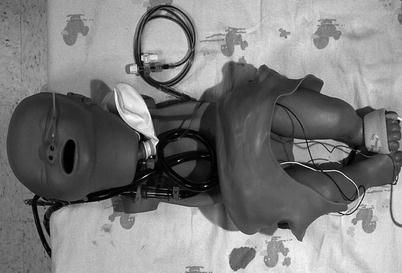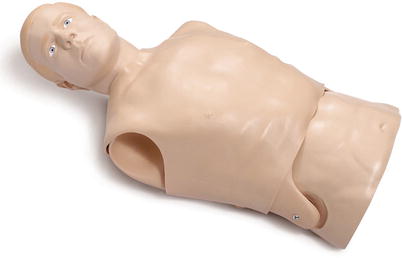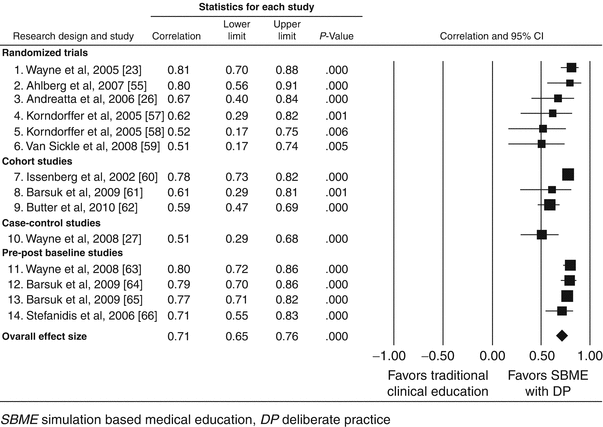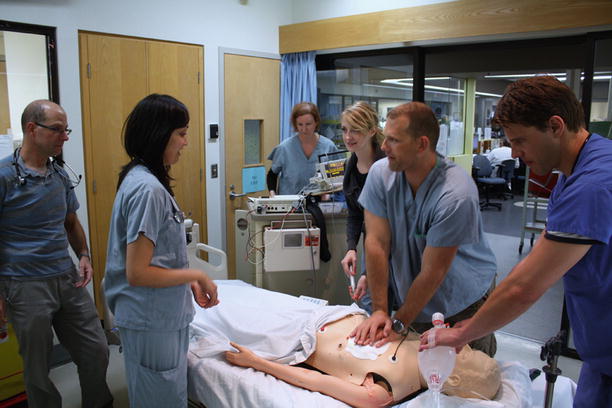Fig. 37.1
Part-Task trainer to help teach endotracheal intubation (Used with permission of Laerdal)
Dr. Mayo and colleagues have published a series of studies investigating the use of simulation as part of a training program for initial airway management skills (i.e., bag-mask ventilation and preparation for intubation). They found that both interns and senior residents can effectively learn to perform these skills by participating in a 30-min session that utilizes deliberate practice with a high-fidelity human patient simulator and comprehensive debriefing [10, 11]. Interestingly, the outcomes for interns taking these sessions were similar whether the session was taught by attending physicians or by house staff, which included postgraduate year 2 or 3 residents completing ICU rotations, chief residents, or pulmonary fellows [12]. This supports the notion that content expertise is not necessarily a prerequisite for instructors of simulation sessions and highlights the importance of providing trainees with the opportunity to simply practice a procedure in a hands-on fashion. Importantly, this group also found that participants continued to use the skills they learned in the session when performing initial airway management with real patients, suggesting that skills taught through simulation are potentially transferrable to and sustainable in the clinical environment [10].
Only one study in the critical care setting has described the potential impact of simulation training on endotracheal intubation (ETI) [13]. As part of an intensive quality improvement initiative for ETI at their center, Mayo and colleagues trained pulmonary/critical care fellows on the technique of endotracheal intubation and the process of team leadership. Over a period of 3 years, they were able to demonstrate that trainees had complication rates similar to those previously reported in the anesthesia literature and deemed the quality improvement process to be a success. Given the high risk of potential complications associated with out-of-operating-room emergency ETIs [14] and the specific skillset required to manage these situations, further investigations to delineate the role that simulation has in optimizing performance should be undertaken.
Central Venous Catheterization
Central venous catheters (CVC) are frequently required in the critical care environment [15]. However, insertion of these catheters is not without risk [16]. While the use of ultrasound guidance for venous cannulation has led to a reduction in the complication rate, training with simulation provides promise for further improvements in the safety profile of this invasive procedure [17].
A recent meta-analysis found that simulation-based training for CVC insertion was associated with high learner satisfaction, improved learner confidence in their ability to perform the procedure, and better ability to actually perform the procedure on a mannequin [17]. Additionally, there is preliminary evidence to suggest that simulation training for CVCs could have a “snowball effect.” To illustrate, Barsuk et al. found that after training 1 year of residents to perform CVC with high-fidelity mannequins, junior residents in each of two subsequent years had improved skills at baseline compared to those who came before them [18]. On a baseline assessment of their ability to insert internal jugular catheters, junior residents’ scores went from 46.7% in 2007 to 55.7% in 2008 and 70.8% in 2009 (P < .001). The authors hypothesized an increase in the quantity and/or the quality of bedside CVC teaching that each successive year of junior residents received from senior residents could be responsible and that this unforeseen side effect could have significant benefits for medical trainees and the healthcare system alike. As discussed in more detail in the “Patient Outcomes” section, there is also evidence to suggest that simulation training for CVCs can lead to improvements in relevant patient outcomes.
Cardiac Life Support
The use of simulation is now considered standard practice when teaching basic or advanced cardiac life support [19–21]. While the majority of the evidence suggests learning cardiac life support with simulation improves future performance on mannequins [22–25] and potentially even positively impacts patient outcomes [26–30], other studies have not found this to be the case [31]. Further complicating matters are the inconsistent results of studies evaluating the impact of mannequin fidelity on relevant outcomes, with some showing improved outcomes with high-fidelity mannequins [22–25, 32–34] and others showing no difference between low- or high-fidelity mannequins [30, 34–36]. Given the available evidence, international guidelines currently recommend simulators be used when training individuals to perform cardiac life support and that either high- or low-fidelity mannequins may be used [20].
Extracorporeal Support
The use of extracorporeal support to sustain critically ill patients is increasing [37]. However, given the complex nature of the technology involved and the potential for catastrophic consequences should technical emergencies arise, there is a need to determine how best to educate ICU personnel in using and troubleshooting bedside extracorporeal support. One approach described by Anderson et al. involved developing an educational intervention that included a high-fidelity simulator modified to accept an extracorporeal circuit [38] (Fig. 37.2). They subsequently demonstrated that participants not only had the subjective belief that the simulator was superior to traditional extracorporeal membrane oxygenation (ECMO) training but that there was also an objective improvement in their technical and behavioral skills following the session [38, 39]. However, a more recent trial failed to demonstrate an improvement in participants’ ECMO-related technical skills after a simulation session, regardless of whether they were being assessed in a simulated or true clinical environment [40]. While there is certainly face validity to use simulation to teach the technical skills associated with ECMO, further investigations need to be undertaken to provide guidance on its optimal use.


Fig. 37.2
ECMO simulator (From Anderson et al. [38]. Printed with permission from Wolters Kluwer Health)
Bronchoscopy
The first description of a high-fidelity computer-based bronchoscopy simulator was published in 1999 [41]. and was followed shortly thereafter by two studies demonstrating that pulmonary and critical care medicine fellows who trained using the simulator had dramatically accelerated learning curves than those trained in the traditional fashion [42, 43]. More recently, perhaps reflecting the growth of interventional pulmonary medicine as a distinct subspecialty, there has been a rapid increase in the number of investigations published [44].
In general, these studies have found that simulation is an effective and efficient way for trainees to acquire bronchoscopy skills. For example, Moorthy et al. found that after five attempts on a virtual reality bronchoscopy simulator, novices were performing at an equivalent level of proficiency on the simulator as bronchoscopists who had performed between 200 and 1,000 bronchoscopies on real patients [45]. Additionally, Wahidi et al. found that pulmonary fellows who received simulator training demonstrated the same level of competency after 20 real bronchoscopies as traditionally trained fellows achieved after 50 bronchoscopies [46]. There is even evidence to suggest that the technical skills learned over a short period of time on a bronchoscopy simulator are transferrable to situations involving real patients. Blum et al. demonstrated that interns trained on a simulator required less assistance and were more thorough when performing bronchoscopy on real patients in the operating room than those interns who had not received training [47].
While the majority of studies have used high-fidelity virtual reality simulators, a wide assortment of lower-fidelity models is also available [44]. The high-fidelity virtual reality simulators have been found to be preferable for learning simple bronchoscopy, but for invasive procedures like transbronchial needle aspiration, low-fidelity models such as those made from plastic or animals are felt to be better at recreating the feel of true human anatomy [48, 49]. Simulators have also been used to help teach other tasks such as chest tube insertion and endobronchial ultrasound (Fig. 37.3).


Fig. 37.3
Mannequin for chest tube insertion (Used with permission of Laerdal)
Other Procedures
The discussion above has focused on a number of procedures that are regularly performed within the domains of pulmonary and critical care medicine. We have not included other potentially relevant procedures because either the role of simulation in teaching that skill has not been rigorously evaluated (e.g., thoracentesis) or extensive evaluations have taken place primarily within other specialties (e.g., endotracheal intubation within the field of anesthesiology). For the latter category, excellent reviews of the relevant evidence can be found in other chapters in this book (chap 17).
Maintenance of Skill
While individuals trained with simulation-based medical education can rapidly achieve a high level of technical competency [27, 46, 50], studies have also shown that these skills may be lost rapidly if not reinforced on a regular basis. Smith et al. randomized 53 residents to be trained to perform CVC insertion with either traditional training throughout their ICU rotation or traditional training plus a one-time simulator session just prior to their ICU rotation [51]. While the residents who were trained with simulators had an initial significant improvement in their performance, 3 months later, their performance had deteriorated and was no different than those residents who had undergone traditional training. The authors hypothesized that because residents did not have the opportunity to practice the skills they had acquired during the simulation (on average, they each inserted less than two CVCs over the course of an entire rotation), they lost any gains that had been made. Similarly, Roy et al. found a significant deterioration in the ability of pediatric residents to appropriately manage life-threatening events from 4 to 8 months after their initial training session, leading the authors to raise the issue of whether more frequent training should be mandated to ensure practitioners maintain competency in this critical skill [52].
While there is some evidence to suggest that certain skills, such as those that rely on algorithms (ACLS management) or motor memory (procedural skills), may be more resistant to decay [53], the higher-order skills mentioned above, such as clinical reasoning, are at higher risk to be lost without ongoing reinforcement [52].
Summary for Technical Skills
The results above are consistent with a recent meta-analysis that demonstrated simulation-based educational sessions were superior to traditional clinical education for teaching technical skills, with a large effect size of 0.71 (95% CI 0.65–0.76; p < 0.001, see Table. 37.1) [54]. In addition, the demonstration of accelerated learning curves when simulators are used to teach procedural skills [67] when combined with the potential decline in these skills over time without deliberate practice [51, 52] suggests that simulation could play an important role in pulmonary and critical care medicine not only for acquiring competency but also for maintaining that competency over the course of a career.


Table. 37.1
Summary of the impact of simulation-based training compared to traditional education (From McGaghie et al. [54]. Printed with permission from Wolters Kluwer Health)
Communication
Effective verbal communication within the healthcare team and between the healthcare team and patients and their families is a crucial component of providing optimal patient care [68]. In particular, in the fast-paced ICU setting, ineffective communication has been shown to be an important risk factor for adverse events [69, 70]. Therefore, it is extremely important to provide healthcare practitioners opportunities to achieve and maintain competency with respect to communication skills.
Simulation-based medical education has been shown to be an effective method not only for novice learners to acquire fundamental communication skills for family meetings in the critical care setting [71] but also for experienced practitioners and teams to refine their existing skills [72, 73]. For example, 40 cardiac arrest teams from a number of different hospitals were found to have significant improvements in leadership, team coordination, and verbalizing situational information after a day-long educational session that involved simulation-based learning of crisis resource management skills [72]. De Vita et al. also demonstrated a significant improvement in crisis resource management skills after medical emergency team (MET) members underwent simulation training [73].
Recently, there has also been increasing interest in exploring the effectiveness of communication between healthcare providers. In particular, the issue of handover, or transfer of patient information from one healthcare provider to another, has been garnering more attention. Each time a handover occurs, important information may be lost [74]. As the number of consecutive hours physicians are able to work continues to decrease, there is an obligatory increase in the number of handovers of patient information that must occur. Therefore, there has been interest in improving the quality of this process in order to minimize the impact of discontinuity of care on patient outcomes [75, 76].
Within the critical care environment, simulation has been used to improve the effectiveness of communication and information transfer during nursing handover at shift change [77]. When compared to baseline, nurses were significantly more effective in communicating key pieces of information like demographics and physiologic data after completing a workshop. The effectiveness of simulation to teach and assess physicians’ communication skills specifically during handover has been used in other specialties [78] but, to our knowledge, has not yet happened in pulmonary or critical care medicine. Given the potential negative impact of discontinuity of care on patients, providing individuals the opportunities to learn these skills, especially within the safe environment made possible with simulation training, should be an educational priority.
Patient Safety
An argument for the development of a simulation-based curriculum that focuses on patient safety and crisis resource management in the ICU has previously been proposed by Fox-Robichaud and Nimmo [79]. After acknowledging the groundbreaking work that anesthesiologists have made by integrating crisis resource management training in their field, the authors highlight a number of differences in the critical care environment, including shared decision-making and managing multiple critically ill patients simultaneously, that justify modifying the “tried and true” methods to achieve additional ICU-specific competencies. There are now numerous examples of simulation-based initiatives that have been developed to improve patient safety within the critical care environment.
For example, mock codes conducted throughout a hospital have been used not only to improve how the cardiac arrest team functions but can also be used to help optimize logistics at a systems level (see Chap. 10). Villamaria et al. describe the use of mock codes not only to help orient the code blue team to a new hospital but also to troubleshoot the building in order to improve patient safety [80]. After conducting 12 mock codes in different areas of the hospital, they identified issues such as locked doors, inadequate phone access, and suboptimal crash cart placement, all of which were subsequently addressed prior to any actual patient harm as a consequence of these system deficiencies.
Another example of simulation being used to improve patient safety comes from Ford and colleagues [81]. When compared to didactic sessions, nurses who received training with simulation-based sessions had significantly less medication administration errors.
Additionally, Burton et al. used a high-fidelity simulator to provide nurses and respiratory therapists the opportunity to undertake deliberate practice of technical and nontechnical skills related to ECMO [40]. Over the course of the study, significant improvements were seen in participants’ knowledge and attitudes toward safety and their ability to work effectively as a team. Clearly, simulation shows promise as an educational technique for teaching the principles of this important construct to healthcare professionals.
Patient Outcomes
There is increasing evidence that structured simulation-based education that targets mastery learning through deliberate practice can positively impact patient outcomes [82, 83]. Within the fields of pulmonary and critical care medicine, there are a number of studies that provide indirect evidence of this relationship. Examples include improved adherence to ACLS protocols during actual code events [27], decreased number of needle passes during central line insertion [64], and a reduction in the incidence of catheter-related bloodstream infections (CRBSI) [84]. While this last example led to a significant cost savings of over $700,000 per year [85], the impact that the decrease in CRBSI had on direct patient outcomes such as length of stay or mortality was not reported.
One recent study in the critical care environment provides more direct evidence that a positive relationship between simulation-based medical education and patient outcomes may exist. Over a 4-year period, Andreatta et al. conducted an increasing number of simulated codes with debriefings as part of an educational initiative for residents and code team members at one hospital [26]. They found a significant increase in the number of patients who survived code blues, rising from a baseline of 33–56% after the fourth year of implementation. While there were a number of limitations with the design of the study including lack of information regarding individual resident performance and some important details of the codes themselves, this still provides a strong signal that simulation-based medical education has the potential to improve patient outcomes.
Importantly, the vast majority of the relevant studies in this area have compared simulation-based medical education to no intervention [82]. Therefore, results need to be interpreted with this in mind and future studies designed to provide a realistic comparison of educational techniques.
Assessment and Evaluation
As medical education moves toward a competency-based framework [86], simulation is poised to take on a greater role in assessment and evaluation because of its ability to assess what medical professionals’ actually do, rather than simply what they say they would do [87]. This may be particularly important within the specialties of pulmonary and critical care medicine as many of the required core competencies, including technical skills, ability to communicate, and team-based care, are extremely difficult to assess with written exams or other traditional methods of assessment [79].
For example, the creation of reliable and valid checklists now allows for objective assessments to take place for technical skills such as endotracheal intubation [88], advanced cardiac life support protocols [23], central venous catheter insertion [89] and bronchoscopy [90], communication skills [91], and complex patient management skills [92–95]. While simulation has been used almost exclusively for formative assessments within the specialties of pulmonary and critical care medicine, given the rapid advances being made in simulation technology and development of assessment tools with rigorous psychometric properties, it may now be ready for use in high-stakes certifying examinations at a national level, much like it has in other specialties [96, 97].
Within a competency-based training framework, simulation assessments at regular intervals could provide useful information to both program directors and trainees. For example, Wahidi et al. found that pulmonary trainees demonstrated significant interindividual variation in their skill level despite having performed the same number of bronchoscopies [46]. Therefore, information from these assessments could be used to create and periodically modify a more personalized schedule of learning experiences for each trainee over the course of their residency based on their specific needs. Once a physician has completed their training, simulation could also be used as a tool to assess maintenance of competency over time, identify areas for remediation, or to assess to what degree a disability or impairment impacts clinical performance [98].
In addition to evaluating the performances of individuals, simulation can be used to assess teams or systems. Marsch et al. used a high-fidelity human patient simulator to assess the quality of care provided during mock cardiac arrests in the intensive care unit [99]. They found that there were significant gaps in quality of care, such as delays in initiation and subsequent suboptimal quantity of CPR provided, and that there was lack of creation of an effective team environment. This powerful information was subsequently used to create initiatives to improve patient care.
With its ability to consistently recreate scenarios in a standard fashion, simulation has the potential to play an important role in formative, summative, and certifying assessments of individual medical professionals, teams, and systems within the specialties of pulmonary and critical care medicine.
Overall Comment on the State of the Science
In general, simulation has been shown to be at least equivalent, if not superior in performance to traditional methods of education [82]. While the evidence base for simulation continues to grow at a rapid pace, there remain significant gaps in our knowledge that we need to fill in order to best guide exactly when, how, and for what simulation should be used in the specialties of pulmonary and critical care medicine.
The Art of Critical Care Simulation
Much like in other areas of medicine, when evidence is still in evolution, relying on experience and best judgment to make decisions is the next best option. Based on the experiences of others and our own, in this section we outline a number of key issues that warrant consideration when aiming for a successful simulation experience within pulmonary and critical care medicine, they include places, people, pedagogy, and practicality.
Places
Traditionally, large stand-alone simulation centers have been constructed in an attempt to centralize both technical and human resources. While these centers still play an important role in conducting large-scale scheduled simulation endeavors, in recent years there has been a movement toward the use of in situ simulation within critical care medicine because of a number of potential advantages [100]. First, learning in the same environment in which that knowledge or skillset will later be used has previously been demonstrated to improve learning outcomes [101, 102] and even potentially contribute to improved patient outcomes [26].
Second, in situ simulation provides tremendous flexibility. Similar to anesthesia and the surgical specialties, some aspects of pulmonary and critical care medicine occur within a defined environment and therefore lend themselves nicely to training in simulation laboratories. However, because other aspects, like cardiac arrests or medical emergency team calls, can occur in any part of the hospital, a simulation laboratory may not be able to accurately replicate the environment. Using in situ simulation, mock cardiac arrests can be performed in any location (hallway, staircase, outside the hospital, etc.) at any time of day or night based on what is needed to achieve the specific learning objectives.
Third, compared to off-site simulation centers, accessibility is dramatically improved; as a result, trainees are more likely to receive simulation-based training when the simulator is readily available [103]. Finally, while the cost to purchase the current generation of portable high-fidelity human patient simulator is still significant, it is significantly less than those required to procure, renovate, and maintain dedicated simulation laboratory space [104]. Given all of these reasons, we have been increasingly using in situ simulation in our ICUs in recent years (Fig. 37.4).


Fig. 37.4
In situ setting for simulation at St. Paul’s Hospital
People
The first group of “people” involved in simulation are the learners. Within the critical care environment in particular, it is important to be cognizant of the wide variety of learners that may be participating. There are not only medical trainees from numerous specialties and at various stages of training but also learners from many other disciplines including nursing, respiratory therapy, pharmacy, social work, and physiotherapy that could be involved in simulation on a daily basis. Additionally, a multitude of other specialties or healthcare services from outside the ICU might be appropriate to be included in sessions. Since a “one-size-fits-all” approach to simulation will not lead to optimal learning outcomes, identifying the various groups and engaging them to determine their learning needs is a worthwhile endeavor.
The second group of “people” are the facilitators and educators involved in making the simulation actually happen. Ideally, a committee of dedicated and enthusiastic individuals with representatives from each of the disciplines listed above should be assembled. They should receive appropriate training, including topics such as curriculum design and evaluation, case development, and debriefing techniques. In addition, ensuring appropriate remuneration and nonmonetary recognition for their efforts is extremely important in order to ensure sustainability of the program. Also, when the simulation involves multiple disciplines, we have found it useful to have a facilitator from each of those disciplines present to provide face validity and content expertise if needed.
It goes without saying that having an individual who takes on the role of “champion” is crucial for developing and sustaining a simulation program. Since there are always more priorities in a healthcare system than there is money or human resources to support, having an enthusiastic and effective leader to ensure that simulation is seen as a valuable priority is extremely important.
Pedagogy
Our approach to any educational session involves three steps: plan, teach, and review.
Stay updated, free articles. Join our Telegram channel

Full access? Get Clinical Tree








